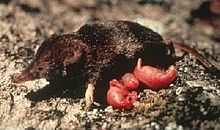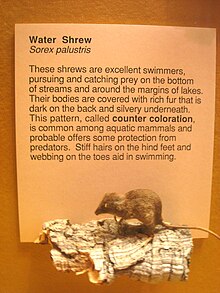American water shrew: Difference between revisions
Calliopejen1 (talk | contribs) →Reproduction: +pic |
Rescuing 1 sources and tagging 0 as dead. #IABot (v1.4) |
||
| Line 29: | Line 29: | ||
== Description == |
== Description == |
||
The American water shrew is considered a species that is [[sexual dimorphism|sexual dimorphic]] in which the males are in general bigger and heavier than the females. The size of the shrew can be anywhere from 130–170 mm and weigh from 8-18 grams. Their tails range from 57–89 mm. The shrew contains black and brown fur colors and changes depending on the season. The color will change to lighter brown in the summer and a black color in the winter.<ref>{{cite web|title=Water Shrew|url=http://www.epa.gov/housatonic/thesite/restofriver/reports/final_era/B%20-%20Focus%20Species%20Profiles/EcoRiskProfile_water_shrew.pdf}}</ref> Air bubbles are trapped in the thick fur when the animal dives underwater. The air bubbles help the shrew with buoyancy and also allow it to engage in a behavior called “water-walking”. The water shrew can dive underwater for about 15 seconds, but is only able to if it is swimming vigorously. The air bubbles allow the shrew to swim, but as soon as the shrew stops swimming, then it will shoot back up to the surface.<ref>{{cite web|last1=DeGraaf|first1=Richard|last2=Rudis|first2=Deborah|title=Water Shrew|url=http://www.mass.gov/eea/docs/dfg/nhesp/species-and-conservation/nhfacts/sorpal.pdf}}</ref> Its feet have a fringe of hairs, more visible on the larger hind feet, which allow this animal to run on the water's surface. |
The American water shrew is considered a species that is [[sexual dimorphism|sexual dimorphic]] in which the males are in general bigger and heavier than the females. The size of the shrew can be anywhere from 130–170 mm and weigh from 8-18 grams. Their tails range from 57–89 mm. The shrew contains black and brown fur colors and changes depending on the season. The color will change to lighter brown in the summer and a black color in the winter.<ref>{{cite web|title=Water Shrew |url=http://www.epa.gov/housatonic/thesite/restofriver/reports/final_era/B%20-%20Focus%20Species%20Profiles/EcoRiskProfile_water_shrew.pdf |deadurl=yes |archiveurl=https://web.archive.org/web/20141209153302/http://www.epa.gov/housatonic/thesite/restofriver/reports/final_era/B%20-%20Focus%20Species%20Profiles/EcoRiskProfile_water_shrew.pdf |archivedate=2014-12-09 }}</ref> Air bubbles are trapped in the thick fur when the animal dives underwater. The air bubbles help the shrew with buoyancy and also allow it to engage in a behavior called “water-walking”. The water shrew can dive underwater for about 15 seconds, but is only able to if it is swimming vigorously. The air bubbles allow the shrew to swim, but as soon as the shrew stops swimming, then it will shoot back up to the surface.<ref>{{cite web|last1=DeGraaf|first1=Richard|last2=Rudis|first2=Deborah|title=Water Shrew|url=http://www.mass.gov/eea/docs/dfg/nhesp/species-and-conservation/nhfacts/sorpal.pdf}}</ref> Its feet have a fringe of hairs, more visible on the larger hind feet, which allow this animal to run on the water's surface. |
||
== Dentition and eating habits == |
== Dentition and eating habits == |
||
Revision as of 22:35, 3 July 2017
| ||||||||||||||||||||||||||||
 | ||||||||||||||||||||||||||||
Wikispecies has information related to Sorex palustris. | ||||||||||||||||||||||||||||
Wikimedia Commons has media related to Sorex palustris. | ||||||||||||||||||||||||||||
The American water shrew (Sorex palustris) or northern water shrew, is found in the nearctic faunal region located throughout the mountain ranges of northern United States and in Canada and Alaska.[3]
Description
The American water shrew is considered a species that is sexual dimorphic in which the males are in general bigger and heavier than the females. The size of the shrew can be anywhere from 130–170 mm and weigh from 8-18 grams. Their tails range from 57–89 mm. The shrew contains black and brown fur colors and changes depending on the season. The color will change to lighter brown in the summer and a black color in the winter.[4] Air bubbles are trapped in the thick fur when the animal dives underwater. The air bubbles help the shrew with buoyancy and also allow it to engage in a behavior called “water-walking”. The water shrew can dive underwater for about 15 seconds, but is only able to if it is swimming vigorously. The air bubbles allow the shrew to swim, but as soon as the shrew stops swimming, then it will shoot back up to the surface.[5] Its feet have a fringe of hairs, more visible on the larger hind feet, which allow this animal to run on the water's surface.
Dentition and eating habits
The American water shrew has a larger skull ranging from 21 to 23 mm and width 10 to 11 mm and contains a dental formula of 1/1 5/1 1/1 3/3 with a total of 32 teeth. They swim well and make short dives in search of food. The shrew prefers aquatic insects such as; stone flies and crane flies. They are known to also feed on small fish, vegetation, and snails. Shrews require a lot of food and cannot go without food for anymore than three hours because of their high metabolic rate.[3] It is thought that they use echolocation to help find prey.
Reproduction

The American water shrew tends to breed from December to September and females usually have a three-week gestation period where offspring will be born in the spring and summer. They usually produce two to three litters during that time. These litters can contain anywhere from three to ten offspring.[3]
Subspecies
The American water shrew has nine subspecies:[1]
|
|
|
See also
References
- ^ a b Hutterer, R. (2005). Wilson, D.E.; Reeder, D.M. (eds.). Mammal Species of the World: A Taxonomic and Geographic Reference (3rd ed.). Johns Hopkins University Press. p. 294. ISBN 978-0-8018-8221-0. OCLC 62265494.
- ^ Template:IUCN2009.2
- ^ a b c Carmen, Ma. "Sorex palustris water shrew". Animal Diversity Web.
- ^ "Water Shrew" (PDF). Archived from the original (PDF) on 2014-12-09.
{{cite web}}: Unknown parameter|deadurl=ignored (|url-status=suggested) (help) - ^ DeGraaf, Richard; Rudis, Deborah. "Water Shrew" (PDF).


